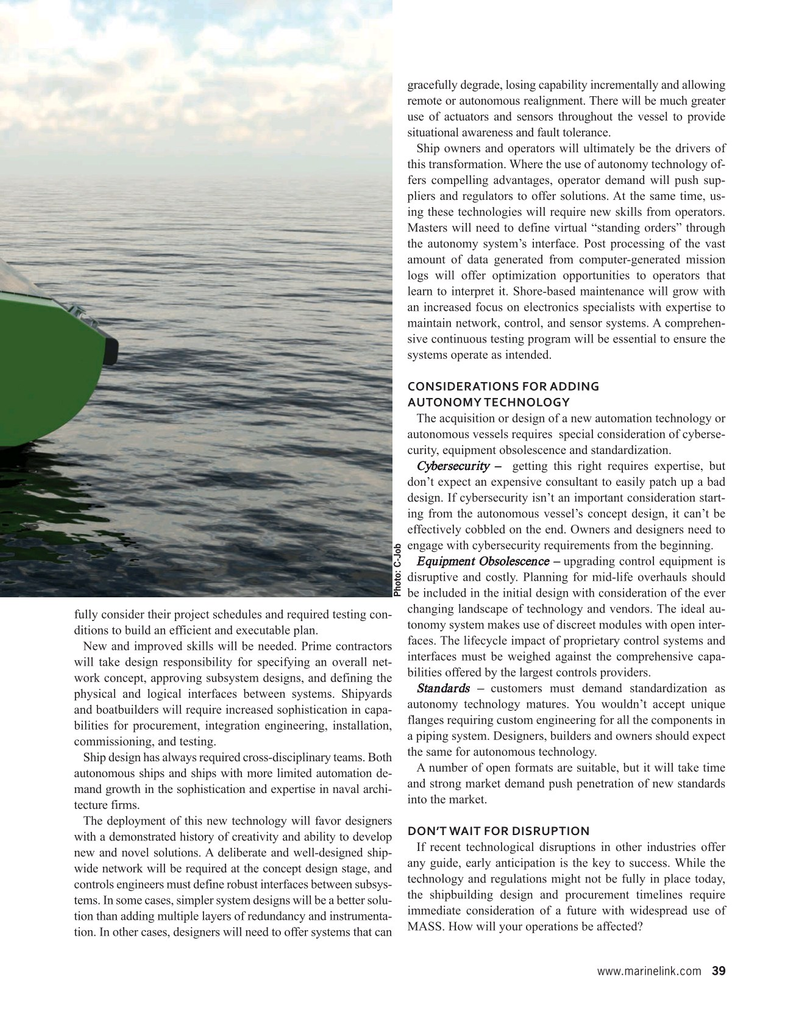
Page 39: of Maritime Reporter Magazine (July 2020)
Maritime Power Edition
Read this page in Pdf, Flash or Html5 edition of July 2020 Maritime Reporter Magazine
gracefully degrade, losing capability incrementally and allowing remote or autonomous realignment. There will be much greater use of actuators and sensors throughout the vessel to provide situational awareness and fault tolerance.
Ship owners and operators will ultimately be the drivers of this transformation. Where the use of autonomy technology of- fers compelling advantages, operator demand will push sup- pliers and regulators to offer solutions. At the same time, us- ing these technologies will require new skills from operators.
Masters will need to define virtual “standing orders” through the autonomy system’s interface. Post processing of the vast amount of data generated from computer-generated mission logs will offer optimization opportunities to operators that learn to interpret it. Shore-based maintenance will grow with an increased focus on electronics specialists with expertise to maintain network, control, and sensor systems. A comprehen- sive continuous testing program will be essential to ensure the systems operate as intended.
CoNsiderAtioNs for AddiNg
AUtoNoMy teChNology
The acquisition or design of a new automation technology or autonomous vessels requires special consideration of cyberse- curity, equipment obsolescence and standardization.
Cybersecurity – getting this right requires expertise, but don’t expect an expensive consultant to easily patch up a bad design. If cybersecurity isn’t an important consideration start- ing from the autonomous vessel’s concept design, it can’t be effectively cobbled on the end. Owners and designers need to engage with cybersecurity requirements from the beginning.
Equipment Obsolescence – upgrading control equipment is disruptive and costly. Planning for mid-life overhauls should
Photo: C-Job be included in the initial design with consideration of the ever changing landscape of technology and vendors. The ideal au- fully consider their project schedules and required testing con- tonomy system makes use of discreet modules with open inter- ditions to build an efficient and executable plan.
New and improved skills will be needed. Prime contractors faces. The lifecycle impact of proprietary control systems and interfaces must be weighed against the comprehensive capa- will take design responsibility for specifying an overall net- work concept, approving subsystem designs, and defining the bilities offered by the largest controls providers.
Standards – customers must demand standardization as physical and logical interfaces between systems. Shipyards autonomy technology matures. You wouldn’t accept unique and boatbuilders will require increased sophistication in capa- bilities for procurement, integration engineering, installation, flanges requiring custom engineering for all the components in a piping system. Designers, builders and owners should expect commissioning, and testing. the same for autonomous technology.
Ship design has always required cross-disciplinary teams. Both
A number of open formats are suitable, but it will take time autonomous ships and ships with more limited automation de- and strong market demand push penetration of new standards mand growth in the sophistication and expertise in naval archi- into the market.
tecture firms.
The deployment of this new technology will favor designers doN’t wAit for disrUPtioN with a demonstrated history of creativity and ability to develop
If recent technological disruptions in other industries offer new and novel solutions. A deliberate and well-designed ship- wide network will be required at the concept design stage, and any guide, early anticipation is the key to success. While the technology and regulations might not be fully in place today, controls engineers must define robust interfaces between subsys- the shipbuilding design and procurement timelines require tems. In some cases, simpler system designs will be a better solu- immediate consideration of a future with widespread use of tion than adding multiple layers of redundancy and instrumenta-
MASS. How will your operations be affected?
tion. In other cases, designers will need to offer systems that can www.marinelink.com 39

 38
38

 40
40
